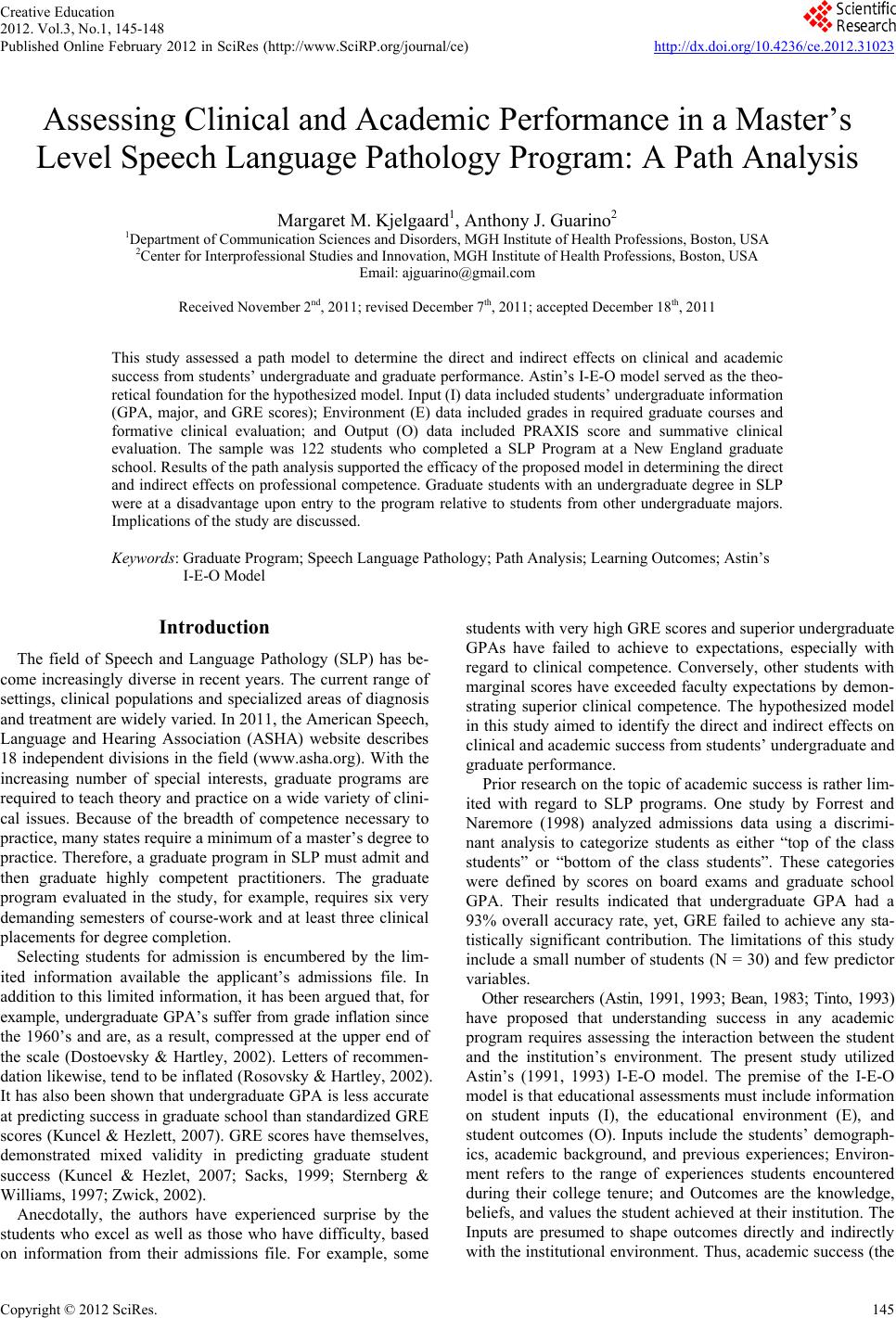
Creative Education
2012. Vol.3, No.1, 145-148
Published Online February 2012 in SciRes (http://www.SciRP.org/journal/ce) http://dx.doi.org/10.4236/ce.2012.31023
Copyright © 2012 SciRes. 145
Assessing Clinical and Academic Performance in a Master’s
Level Speech Language Pathology Program: A Path Analysis
Margaret M. Kjelgaard1, Anthony J. Guarino2
1Department of Communication Sciences and Disorders, MGH Institute of Health Professions, Boston, USA
2Center for Interprofessional Studies and Innovation, MGH Institute of Health Professions, Boston, USA
Email: ajguarino@gmail.com
Received November 2nd, 2011; revised December 7th, 2011; accepted December 18th, 2011
This study assessed a path model to determine the direct and indirect effects on clinical and academic
success from students’ undergraduate and graduate performance. Astin’s I-E-O model served as the theo-
retical foundation for the hypothesized model. Input (I) data included students’ undergraduate information
(GPA, major, and GRE scores); Environment (E) data included grades in required graduate courses and
formative clinical evaluation; and Output (O) data included PRAXIS score and summative clinical
evaluation. The sample was 122 students who completed a SLP Program at a New England graduate
school. Results of the path analysis supported the efficacy of the proposed model in determining the direct
and indirect effects on professional competence. Graduate students with an undergraduate degree in SLP
were at a disadvantage upon entry to the program relative to students from other undergraduate majors.
Implications of the study are discussed.
Keywords: Graduate Program; Speech Language Pathology; Path Analysis; Learning Outcomes; Astin’s
I-E-O Model
Introduction
The field of Speech and Language Pathology (SLP) has be-
come increasingly diverse in recent years. The current range of
settings, clinical populations and specialized areas of diagnosis
and treatment are widely varied. In 2011, the American Speech,
Language and Hearing Association (ASHA) website describes
18 independent divisions in the field (www.asha.org). With the
increasing number of special interests, graduate programs are
required to teach theory and practice on a wide variety of clini-
cal issues. Because of the breadth of competence necessary to
practice, many states require a minimum of a master’s degree to
practice. Therefore, a graduate program in SLP must admit and
then graduate highly competent practitioners. The graduate
program evaluated in the study, for example, requires six very
demanding semesters of course-work and at least three clinical
placements for degree completion.
Selecting students for admission is encumbered by the lim-
ited information available the applicant’s admissions file. In
addition to this limited information, it has been argued that, for
example, undergraduate GPA’s suffer from grade inflation since
the 1960’s and are, as a result, compressed at the upper end of
the scale (Dostoevsky & Hartley, 2002). Letters of recommen-
dation likewise, tend to be inflated (Rosovsky & Hartley, 2002).
It has also been shown that undergraduate GPA is less accurate
at predicting success in graduate school than standardized GRE
scores (Kuncel & Hezlett, 2007). GRE scores have themselves,
demonstrated mixed validity in predicting graduate student
success (Kuncel & Hezlet, 2007; Sacks, 1999; Sternberg &
Williams, 1997; Zwick, 2002).
Anecdotally, the authors have experienced surprise by the
students who excel as well as those who have difficulty, based
on information from their admissions file. For example, some
students with very high GRE scores and superior undergraduate
GPAs have failed to achieve to expectations, especially with
regard to clinical competence. Conversely, other students with
marginal scores have exceeded faculty expectations by demon-
strating superior clinical competence. The hypothesized model
in this study aimed to identify the direct and indirect effects on
clinical and academic success from students’ undergraduate and
graduate performance.
Prior research on the topic of academic success is rather lim-
ited with regard to SLP programs. One study by Forrest and
Naremore (1998) analyzed admissions data using a discrimi-
nant analysis to categorize students as either “top of the class
students” or “bottom of the class students”. These categories
were defined by scores on board exams and graduate school
GPA. Their results indicated that undergraduate GPA had a
93% overall accuracy rate, yet, GRE failed to achieve any sta-
tistically significant contribution. The limitations of this study
include a small number of students (N = 30) and few predictor
variables.
Other researchers (Astin, 1991, 1993; Bean, 1983; Tinto, 1993)
have proposed that understanding success in any academic
program requires assessing the interaction between the student
and the institution’s environment. The present study utilized
Astin’s (1991, 1993) I-E-O model. The premise of the I-E-O
model is that educational assessments must include information
on student inputs (I), the educational environment (E), and
student outcomes (O). Inputs include the students’ demograph-
ics, academic background, and previous experiences; Environ-
ment refers to the range of experiences students encountered
during their college tenure; and Outcomes are the knowledge,
beliefs, and values the student achieved at their institution. The
Inputs are presumed to shape outcomes directly and indirectly
with the institutional environment. Thus, academic success (the